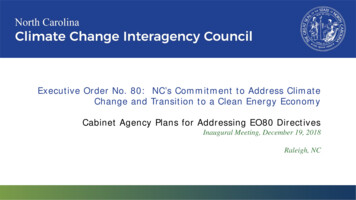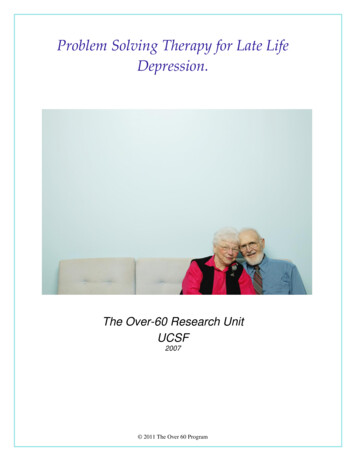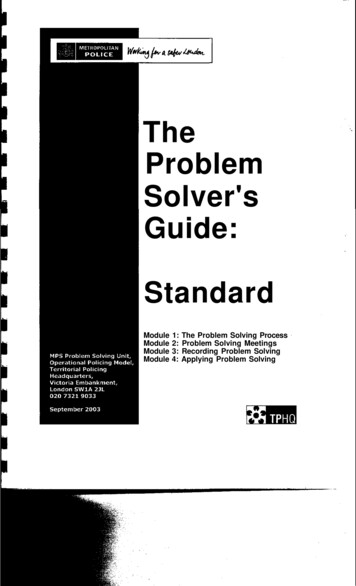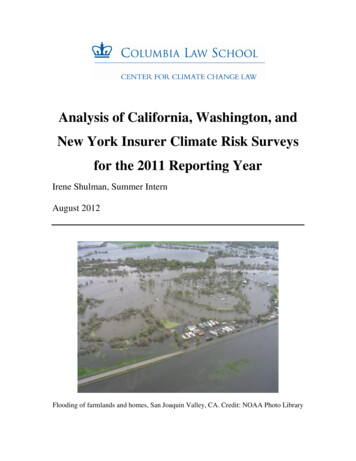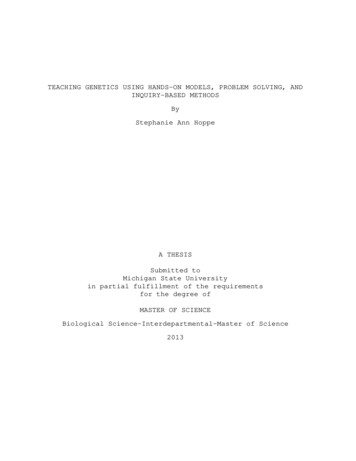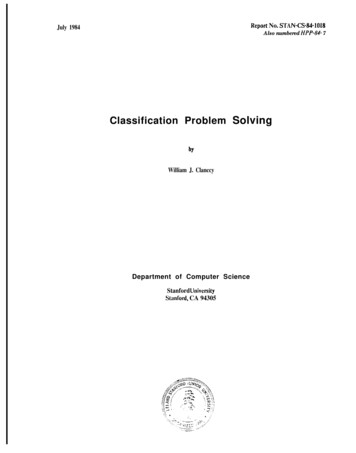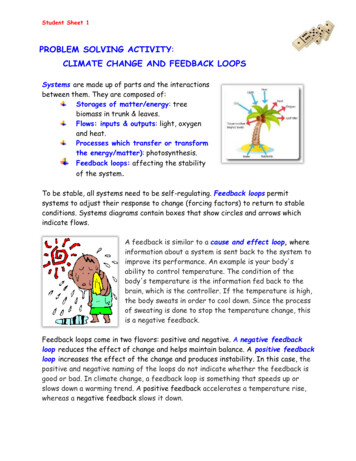
Transcription
Student Sheet 1PROBLEM SOLVING ACTIVITY:CLIMATE CHANGE AND FEEDBACK LOOPSSystems are made up of parts and the interactionsbetween them. They are composed of:Storages of matter/energy: treebiomass in trunk & leaves.Flows: inputs & outputs: light, oxygenand heat.Processes which transfer or transformthe energy/matter): photosynthesis.Feedback loops: affecting the stabilityof the system.To be stable, all systems need to be self-regulating. Feedback loops permitsystems to adjust their response to change (forcing factors) to return to stableconditions. Systems diagrams contain boxes that show circles and arrows whichindicate flows.A feedback is similar to a cause and effect loop, whereinformation about a system is sent back to the system toimprove its performance. An example is your body'sability to control temperature. The condition of thebody's temperature is the information fed back to thebrain, which is the controller. If the temperature is high,the body sweats in order to cool down. Since the processof sweating is done to stop the temperature change, thisis a negative feedback.Feedback loops come in two flavors: positive and negative. A negative feedbackloop reduces the effect of change and helps maintain balance. A positive feedbackloop increases the effect of the change and produces instability. In this case, thepositive and negative naming of the loops do not indicate whether the feedback isgood or bad. In climate change, a feedback loop is something that speeds up orslows down a warming trend. A positive feedback accelerates a temperature rise,whereas a negative feedback slows it down.
Student Sheet 2Scientists have identified several positivefeedbacks loops in the climate system.Ocean warming provides a good example ofa potential positive feedback mechanism.The oceans are an important sink for CO2through absorption of the gas into thewater surface. As CO2 increases, itincreases the warming potential of theatmosphere. If air temperatures warm, itshould warm the oceans. The ability of the ocean to remove CO2 from theatmosphere decreases with increasing temperature. Because of this, increasingCO2 in the atmosphere could have effects that actually intensify the increase inCO2 in the atmosphere.A good example of a negative feedback mechanismwill be if the increase in temperature increases theamount of cloud cover. The increased cloudthickness or amount could reduce incoming solarradiation and limit warming. At the same time, it isnot clear, that if additional cloud cover happens, atwhat latitudes and at what times it might occur.Also, it is not clear what types of clouds might becreated. Thick low clouds would have a strongerability to block sunlight than extensive high (cirrus)type clouds.Various other feedbacks – related to emissions from soils andpermafrost, for example, and changes to ocean evaporation – are knownor thought to exist. Feedback loops such as these are very complex inthemselves and even more complex when considered as part of anintegrated global climate system. Some are already at work, while othershave yet to kick in. Others still – both positive and negative – may yet bediscovered.
THE SCENARIOAt an international conference on climate change, new informationwas presented by a team of scientists from Great Britain. Many of thepeople attending the conference are unclear about their findings andneed more and better information. Your team of climate specialistshas been asked to analyze their data and report back with yourfindings to the group at a later date. Their theory was presented inthe form of a feedback loop with which you have extensiveexperience.“If the temperature of the Earth rises significantly as a result ofan enhanced greenhouse effect (global warming) the speed of globalwinds will increase. Increased wind speed will cause a greaterdisturbance of ocean water, which then will cause larger clouds toform. The clouds might either increase or decrease the Earth'saverage global temperature.”TASK:1. Imagine that you are a scientist at the conference and have beengiven a copy of a diagram illustrating the feedback mechanismdescribed by the British scientists.2. Your job is to interpret the diagram, analyze how this particularfeedback mechanism might influence global warming and reportback to the conference members.3. Answer the questions below and use them as a guide to planningyour presentation.4. Create a visual representation of your report to help clarify theproblem for your audience.
Guide Questions for Relating Cause and Effect1. According to the diagram, what changes will occur inthe atmosphere as a result of global warming?2. What do you think will cause these changes to occur?3. How will the changes in the atmosphere affect theocean? Explain.4. How will the changes in the ocean affect cloudformation?5. Based on your knowledge of weather and climate, how mightlarger clouds make the Earth warmer? How might largerclouds make the Earth cooler?6. Do you think that this feedback mechanism willincrease (a positive feedback) or decrease (anegative feedback) the effects of global warming? Why?
Higher atmospherictemperaturesHigher ocean wavesHigher wind speedsHeat energyMore saltparticlesreleased into airGLOBAL WARMINGSalt particles becomenuclei for cloudsWhat effect?Bigger cloudsANALYZING A FEEDBACK LOOP
A negative feedback loop reduces the effect of change and helps maintain balance. A positive feedback loop increases the effect of the change and produces instability. In this case, the positive and negative naming of the loops do not indicate whether the feedback is good or bad. In climate change, a feedback loop is something that speeds up or

